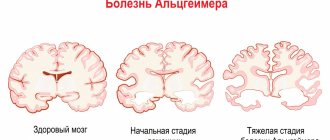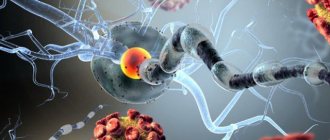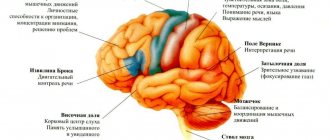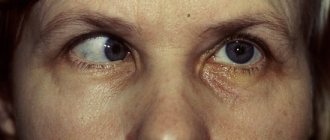Multiple sclerosis
(MS) is a chronic, incurable autoimmune disease. Pathological processes (demyelination) affect the myelin sheaths of neurons in the brain and spinal cord. Healthy tissue is replaced by dense connective tissue, the scar type. It does not conduct nerve impulses, which leads to various neurological symptoms.
Diagnosis of multiple sclerosis at the initial stage of the disease is difficult. It is important to have complete, regular medical checkups. In this case, it is possible to detect the onset of the disease and begin timely treatment. This will help to significantly slow down pathological changes and prolong the patient’s ability to work for a long time.
tests
Causes of multiple sclerosis
At the moment, the exact cause of the disease has not been established. Some of the most likely factors influencing the development of MS are:
- previous viral or bacterial infections;
- prolonged exposure to increased radiation fields;
- chronic poisoning with toxic substances;
- poor quality, inadequate nutrition;
- unfavorable environmental conditions;
- previous injuries;
- frequent stressful situations.
According to statistics, the disease most often occurs at a young age, under 40 years of age. However, it is rare, but still occurs both in children under 15 years of age and in older people. It is more often diagnosed in females; there are female patients for every male. Not only gender matters, but also race. Caucasians are more prone to multiple sclerosis.
The incidence is higher in large, industrial cities, which may indicate the influence of unfavorable environmental conditions and stress. Russia is a high-risk zone, since more than 30 patients are diagnosed here for every 100 thousand people.
Manifestation of multiple sclerosis
Symptoms depend on the location of the most severe demyelination.
1. If the pyramidal system is damaged:
- Increased tendon-periosteal reflexes that occur in response to stimuli.
- Decreased muscle strength and increased muscle fatigue while maintaining functionality.
- Tetraparesis is increased tone of a particular muscle group.
2. With damage to the cerebellum:
- Ataxia (impaired coordination of movements) of the trunk and limbs.
- Intention tremor (vibrations of the whole body or its parts due to uncontrolled muscle contractions).
- Muscular hypotonia (decreased muscle tone and strength up to paresis).
3. When neurons are damaged, paralysis of the following nerves may occur:
- facial;
- oculomotor;
- sublingual;
- trigeminal nerve.
4. Other symptoms of MS:
- bulbar and pseudobulbar syndromes;
- nystagmus - involuntary eye movements;
- joint and muscle pain;
- loss of tactile sensitivity;
- a feeling of pressure in the limbs;
- superficial tingling in the fingers;
- incontinence and retention of urine and bowel movements;
- sexual dysfunction;
- decreased visual acuity and quality (loss of brightness, distorted color perception).
Neuropsychological changes are also observed in multiple sclerosis. They consist in changing habits, reducing mental abilities, resulting in specific organic dementia. Patients suffer from depression, alternating with periods of euphoria, and often lose control of their emotions. Emotional instability, i.e. rapid changes in mood, which is considered one of the early symptoms. To assess the severity of symptoms, a scale from 0 to 6 is used, and the degree of disability of a patient with MS is scored from 0 to 10 on the EDSS scale.
Symptoms of the disease
The symptoms accompanying the disease depend entirely on which part of the person’s body is affected by the disease. In this pathology, symptoms may appear and disappear, which complicates the process of identifying a dangerous disease. True, there are also constant symptoms of the disease:
- weakness of the body;
- lack of strength in the limbs;
- vision loss and recovery;
- loss of sensation in the limbs;
- frequent headaches;
- periodic dizziness;
- inaccurate movement coordination;
- loss of erectile function;
- impotence may occur.
If this disease is not treated, the symptoms intensify and lead to:
- complete impairment of the visual functions of the body;
- impaired speech ability;
- failure to swallow;
- the oral cavity is constantly in a dry state;
- insomnia;
- loss of mental abilities;
- lack of control over urination and sequence of actions;
- dementia manifests itself.
Only with the timely intervention of our specialists, it is possible to stop the development of pathology and partially restore the functioning of all body functions and delay the onset of the “vegetable” state.
Diagnosis of multiple sclerosis
The disease does not have characteristic symptoms unique to it. Therefore, differential diagnosis is always carried out. The doctor needs to rule out a large number of congenital pathologies and diseases of the nervous system. Systemic lupus, stroke, Sjogren's syndrome, Parkinson's and Behçet's diseases have similar changes.
1.
Laboratory diagnostics
When conducting a general blood test, changes in indicators allow one to suspect the development of multiple sclerosis. These include:
- Concentration of lymphocytes - increased content up to 40% or more.
- The number of leukocytes is less than normal.
- Erythrocyte sedimentation rate is increased.
A cerebrospinal fluid puncture will help check for an autoimmune disorder. In MS, a high percentage of immunoglobulins and oligoclonal antibodies (IgG antibodies) will be detected in it.
You can analyze the state of the immune system by doing an immunogram. To do this, it is necessary to donate venous blood for a comprehensive study. It is aimed at identifying the concentration of lymphocytes and immunoglobulins of various types. As a rule, with RSV, the concentration of immune cells is increased, indicating an autoimmune process, and other parameters are decreased, as a result of weakened body defenses.
2. Instrumental diagnostics
The most effective at the moment is considered to be an electromagnetic superposition scan of brain structures (SEMS) or an electroencephalogram. The scan allows you to diagnose multiple sclerosis at an early stage of development, when neurological signs are absent or mild. However, SPEMS has a high error; changes are detected in one case out of three.
The essence of the method is to identify focal losses of myelin. In the presence of pathological changes, the conduction of nerve impulses is disrupted. It is carried out by placing several sensors that monitor bioelectric impulses on the patient’s head. The result is an electroencephalogram - a graphic image of an oscillatory electrical process.
3. Magnetic resonance and computed tomography
Computer and magnetic resonance diagnostics make it possible to assess the state of the nervous system and diagnose MS. The use of a contrast solution helps to increase the efficiency of the study. The drug is administered intravenously and does not cause any sensations or discomfort.
The sensitivity of tomography is extremely high, reaching an accuracy of 95%. Allows you to accurately diagnose multiple sclerosis in the following cases:
- detection of 4 or more foci of demyelination;
- diameter of damage to nerve fibers from 3 mm;
- the lesions are located in the nerve fibers, in the cranial fossa, adjacent to the lateral stomachs.
A contrast solution not only helps to increase visibility, but is itself a marker of the presence of pathology. Its accumulation in the lesions indicates an active inflammatory process. A tomogram of the spinal cord is performed in the same way.
Inspection
During a neurological examination, the condition of the central nervous system (CNS) and peripheral nerves is assessed, and pathological neurological symptoms are identified. Together with complaints and medical history, they can serve as criteria for reliable multiple sclerosis. Among these criteria:
- onset of the disease before age 60;
- separation in place, the presence of two or more pathological foci in the central nervous system: for example, difficulty coordinating movements (damage to the cerebellum) is combined with urinary incontinence (focus in the spinal cord) and with impaired vision (the optic nerve is involved);
- separation in time: complaints and symptoms do not appear simultaneously - there is a time interval of at least a month between them;
- symptoms progress slowly: over 6 months. and more;
- symptoms indicate damage to the myelin sheath, which makes up the white matter of the central nervous system;
- symptoms are not caused by other diseases or injuries of the central nervous system.
Unfortunately, it is extremely rare to accurately determine the presence of multiple sclerosis based on subjective data and the clinical picture. And the very principle of separation or dissemination in place and time does not always work. Some symptoms progress, while others, on the contrary, subside and are not always detected during examination. Therefore, in most cases they talk only about probable, and not about certain, multiple sclerosis. To establish the truth, instrumental and laboratory studies are needed.
Treatment
Multiple sclerosis
This is a chronic disease, the complete cure of which is impossible. All measures are aimed at slowing the progression of the disease, relieving symptoms and reducing the frequency of exacerbations. There is no single treatment plan; each patient requires an individual approach.
The remitting nature of the disease, characterized by periods of weakening and intensification of symptoms, requires symptomatic treatment, prevention of exacerbations, and inhibition of the transition to the active stage. In the secondary, progressive form, the main goal of therapy is to slow the development of sclerosis. The doctor must understand what stage the patient is in. to correct his condition. To do this, the patient regularly undergoes prescribed tests, undergoes research, most often an MRI and an immunological blood test.
Do not forget that in addition to physiological symptoms, the patient undergoes a psychological personality change. May become depressed, experience chronic fatigue, anxiety and depressive disorders. Multiple sclerosis is associated with a wide range of mental disorders: from personality disorders to altered psychotic states. This also requires attention from a doctor.
Main objectives of treatment:
- Prevent exacerbations.
- Slow down the course of the disease.
- Prevent the development of new symptoms and reduce their severity.
- To alleviate the current symptoms, to help the patient lead his usual lifestyle.
An important role is played by the patient’s social adaptation and timely psychological assistance. Despite the fact that the diagnosis of multiple sclerosis is made by a neurologist, a number of specialists are involved in the treatment: an immunologist, an electrophysiologist, a neuro-ophthalmologist, a neuropsychologist, and a urologist.
Therapy at home
When treating and caring at home, the patient requires professional help and constant diagnosis of the disease. This will make it possible to monitor the patient’s condition and not miss the need for urgent therapeutic intervention. Therefore, high-quality treatment and care at home will not work. What can be offered in such a situation is only care without treatment or special measures.
Our boarding house with a medical focus invites you to leave useless activities and turn to us for help. Our specialists will conduct a full diagnosis of the ward and talk about his condition at this hour, advise the correct measures of care or full service in our boarding house.
Advantages of taking tests at JSC SZTsDM
- All types of laboratory tests, including those for diagnosing MS.
- Data accuracy thanks to modern equipment and qualified employees.
- Quick availability of results, several options for obtaining.
- Friendly staff, confidentiality, no queues.
- Convenient location of terminals.
The laboratories of the Northwestern Center for Evidence-Based Medicine are represented in Pskov, Veliky Novgorod, Kaliningrad, St. Petersburg and other cities of the Leningrad region.








